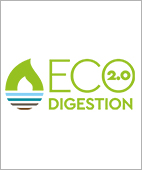
LIFE Project: Scaling up innovative technology for the control and automation of co-digestion in WWTPs to produce green energy on demand
- Type Project
- Status In progress
- Execution 2020 -2025
- Assigned Budget 971,42 €
- Scope Europeo
- Autonomous community Comunitat Valenciana
- Main source of financing LIFE
- Project website Web del proyecto
The LIFE ECOdigestion 2.0 project aims to demonstrate full-scale technology for the automated control of waste dosing in anaerobic digesters at WWTPs, with the aim of producing biogas on demand from sewage sludge and agri-food waste.
Most greenhouse gas (GHG) emissions come from energy production, so renewable energy must play a fundamental role in solving the problem of climate change. If these technologies became an economically and technically viable alternative to conventional fossil fuels, a large-scale reduction in GHG emissions would be achieved.
Furthermore, the agricultural and food sectors produce millions of tons of waste each year, most of which is potentially biodegradable. This waste often has a high water content, which makes transportation expensive and treatment difficult. Co-digestion of this waste with wastewater treatment plant sludge (WWTP) is an alternative treatment with significant potential, as its use transforms the waste into byproducts and biogas, a renewable energy source.
Maximize biogas production and waste treatment capacity with a technology based on a previous project, ECOdigestion (LIFE13 ENV/ES/000377).
Expanding the automatic co-digestion tool at the Quart-Benger WWTP (Spain) with agricultural feedstocks and slurry to obtain energy on demand, with feed recipes generated and updated every 15 minutes.
Achieving targeted biogas production after implementing automated co-substrate dosing.
Increase the amount of manure and agricultural food waste that can be treated by 192%, representing 85,191 t during the full-scale demonstration.
Obtaining 14% more biogas with co-digestion compared to digesting each substrate separately.
Improve the stability of the co-digestion process under different operating conditions with various co-substrates (maintaining the acidity/alkalinity ratio between 0.05-0.15).
Recovering 27,375 t/year of agri-food waste and 102,200 t/year of manure by shifting their disposal from incineration, agriculture, compost, and landfill to co-digestion. This involves:
- i) avoid the emission of GHG, around 7,900 and 16,442 CO2eq in the demonstration of co-digestion of manure and agri-food respectively;
- ii) a total annual methane production from agro-food waste of 2,729,471 Nm3 and 951,400 Nm3 from manure, representing 14,571 MWh and 7,540 MWh, respectively.
Four full-time skilled jobs were consolidated and one was created during the project (specialized technicians).
Regarding the EU-wide impact, implementing the tool in all anaerobic wastewater treatment plants (5,477 wastewater treatment plants) would result in an energy production of around 58,000 GWh/year. Furthermore, it would achieve an annual reduction in greenhouse gases of 66.2 Mt of CO2 and 17.1 t of NOx, and an annual reduction in acid rain-promoting gases of 23.7 t of SO2.
- Coordinator/entity name: Tatiana Montoya
Postal address: GRAN VA MARQUS DEL TURIA, 17, 46005, VALENCIA,
The project contributes to the implementation of EU Directive 2009/28/EC on the promotion of the use of energy from renewable sources, the Waste Framework Directive (2008/98/EC), the EU Circular Economy Action Plan, and the Roadmap to a Resource-Efficient Europe. It is also aligned with EU and international climate change mitigation targets and with Spain's Waste Management Plan (2019-2022).
- GLOBAL OMNIUM MEDIOAMBIENTE, S.L.
- AdCL(águas do Centro Litoral, S.A.)
- Finnova(Finnovaregio Foundation)







